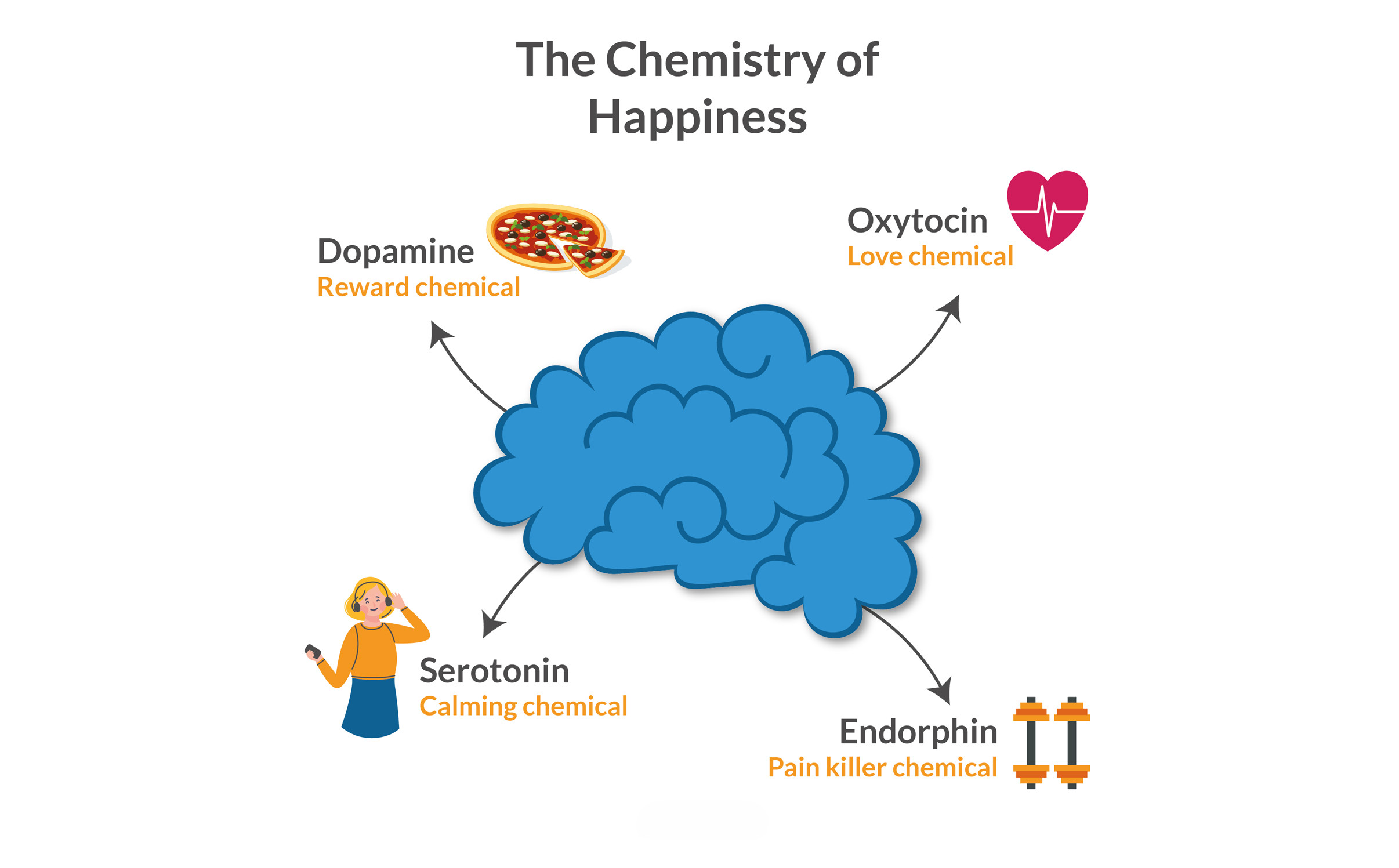4. GET TO KNOW YOUR "HAPPY CHEMICALS."
“Some believe we should always put others first—that if we don’t look out for the group, the group won’t look out for us. Others believe we should always put ourselves first and that if we don’t take care of ourselves first, then we would be of no use to anyone else. The fact is, both are true.” – Simon Sinek
Previous chapters: https://kenkavn.com/news/putting-people-first-lessons-from-leaders-eat-last-333

Based on the quote above, Simon sets the stage for an all-out analysis on why we do what we do. And with his background in biology + anthropology, he starts explaining what makes us tick through the four chemicals in our bodies.
80% of the book is based around these four chemicals and how they drive those of us in leadership roles.
Get to know the four “happy” chemicals in your brain + body
• Endorphin: the pain-masking chemical
• Dopamine: the goal-achieving chemical
• Serotonin: the leadership chemical
• Oxytocin: the chemical of love
We have four chemicals in our bodies that work towards driving our behavior.
Simon calls the first two “Selfish” and the second two “Selfless.”
- “Selfish” chemicals: Endorphins and Dopamine. These work to help us get things done.
- “Selfless” chemicals: Serotonin and Oxytocin. These work to help strengthen our social bonds, fostering connection and collaboration.
Endorphins + dopamine
Endorphins + Dopamine are the chemicals of progress, as they make us feel good when we achieve goals and accomplish various things. So what’s the problem? Most leaders operate with fear-based tactics like the old “command + control” model of management — which has not only been proven NOT to work, but has also been shown to spike our egos and get dopamine surging through our bodies. This often makes US feel good at the expense of others. And that’s bad. Really bad. It’s so bad that it usually bites us in the butt… What’s worse, Endorphins + Dopamine are highly addictive.
Endorphin (The runner's high)
Ever hear of a “runner’s high”? That’s just endorphin surging through your body. It’s there to mask the pain we’re putting our bodies through when we beat up our muscles in the gym, or run for long periods of time. Endorphin was useful back in the paleolithic era when hunters would go all day long in the grueling heat or freezing cold, hunting for food… Endorphin would kick in at just the right time to mask the pain and make us feel good enough to get our bodies to keep moving, and eventually, to capture the prey… It’s likely that hunter-gathers became addicted to hunting, much like some of us become addicted to weight-lifting.
Dopamine (The goal-achieving chemical)
Dopamine is "the dangerous" chemical — but only when abused. Cocaine, nicotine, and alcohol all send dopamine surging through your system... The reason we get addicted to this stuff is that it provides near-instant gratification/pleasure — which, again, is just dopamine making you feel good.
You know what else sends dopamine surging through your system? A sense of completion. (That extra burst of feel-good vibes that arise when we’re approaching the finish line).
Achieving Goals. Completing Tasks. Getting things done…
The gratification of crossing off that jar of almond butter on your grocery list.
That awesome feeling you get when you click that little box and see the check-sign show up on your favorite productivity app.
Dopamine isn’t always rational.
Dopamine was put into place by Mother Nature to incentivize us to move forward with what we’ve committed ourselves to doing by giving us little bursts or “hits” of the dopamine chemical whenever we take a small step towards achieving a desired outcome of some sort.
The problem though is that even the “good” things about dopamine can get addictive.
For example, consider your to-do list…
Do you add obviously easy tasks to the list just to make it seem like you’re getting stuff done?
Imagine you're at the grocery store with a list of items to get, and as you're strolling down the aisles picking up your goodies, you see almond butter on the shelf and remember that you’d actually forgotten to add it to your grocery list. No problem. You grab it and put it in your basket—and then you write ‘almond butter’ down on your grocery list and immediately cross it out.
If you can relate to doing something like this, you're not alone. And the reason it's common is because we tend to become addicted to the short burst of dopamine that results from checking tasks off our lists—regardless of whether it actually makes any logical sense to do so… that’s dopamine.
How do we put these chemicals to use?
Sinek tells a great story about a company named Barry-Wehmiller, and their losing battle against a series of economic blows that sent the company tumbling into a financial crisis they just couldn’t shake.
Although they were advised to begin instituting massive layoffs to keep their business above ground and help them weather the economic storm – they kept pushing back and refusing to sacrifice their employees in hopes that they could come up with something – anything – that could help them survive this financial hardship and continue to provide the members of Barry-Wehmiler with the job-security they deserved.
Unfortunately enough, the day eventually came when they were left with no other choice but to start laying people off.
Until someone came up with a better idea…
(Side note: did you notice how lay-offs were an absolute last resort with this particular company, as opposed to a quick-fix resolution that CEOs of today jump at without a flinch or hint of hesitation?)
The CEO of Barry-Wehmiller, Bob Chapman, decided that he wouldn’t be going down the same road most of his peers – both past and present – usually tend to go down when faced with similar situations, which is a massive onslaught of layoffs in the name of “balancing the books“… This particular CEO however, cared about his people and he decided to demonstrate that by coming up with an idea that would avoid layoffs — and even bring the organization closer together in the process.
Want to know what he did? He instituted a ‘furlough’. This means that every employee (CEO included) was required to take four unpaid weeks off from work per year in order to balance the inevitable financial blows that threaten the survival of any thriving business or company. Sounds pretty simple, doesn’t it? Everyone takes four weeks of unpaid vacation time and the company becomes stable again. Boom.
After reading about this furlough idea, we couldn’t help but think “Wow. Duh. Why haven’t more of us thought of that idea?”
And then we realized why it’s so important for leaders at every level to read this book — Leaders Eat Last is more than just a catchy title filled with inspiring stories — it’s a testament to the few true leaders in the business world today, and a blueprint filled with example after example of how these principles of conscious, caring leadership can be cultivated and applied in the modern businesses of today.
Because of leaders like Bob Chapman, who refused to let his people go when his company hit hard times, the people in the company came together as a unified team to see to it that the organization would make it through the tough times and prosper once again.
And it all began with one person: the leader.
- As a leader, it's important to understand that the buck stops at your desk. That said, it's crucial to ensure you foster an environment like the example we just went over, so that those you lead feel safe, secure, and inspired at work.
- If you're the decision maker when it comes to lay-offs, remind yourself that it doesn't have. to be the only option if your organization is in a financial bind. There are other options. There are always other options. Reserve lay-offs as THE FINAL option—NOT the first.





















0 Comments